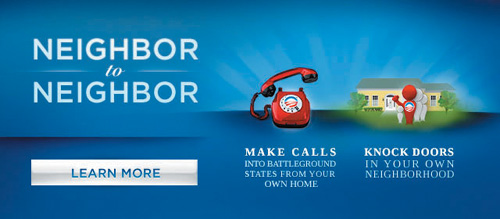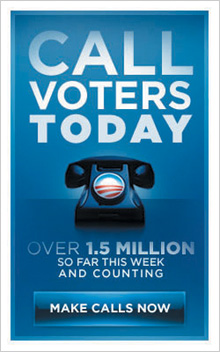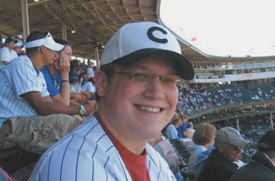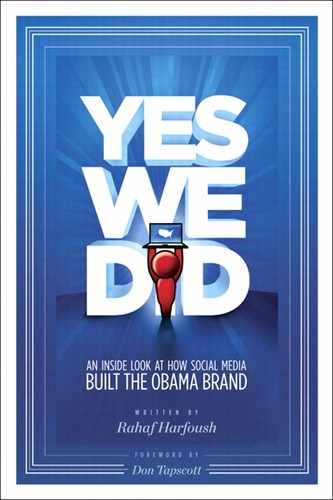7. Neighbor to Neighbor
THE TALKS THAT MATTER
There are many ways for you to have an impact on this campaign, but the single most important thing you can do is to talk directly to voters. There’s nothing more powerful and effective than everyday people reaching out to their neighbors—or people in a neighboring battleground state—and talking about why they support Barack. (Barack Obama HQ Blog)
Neighbor to Neighbor (N2N) was Obama’s online phonebanking tool that allowed supporters to make calls on behalf of the campaign from the comfort of their own home. It was launched in September 2007 as a way to help supporters reach out to undecided voters, recruit volunteers, and quickly share information. Accessed through a user’s MyBO account, N2N added all calls made by a user into his or her activity index.
Voters who wanted to participate in N2N could choose to take part in a phone campaign or a door-to-door canvassing campaign. Phone campaigns targeted specific constituencies (Women for Obama), states (Ohio for Obama), or specific goals (Recruit Volunteers). The Obama team listed the different phone campaigns in order of priority so users would know which ones needed the most immediate support. Phone campaigns also took into account a user’s location to avoid problematic situations such as having California supporters phone voters in Ohio too late in the evening because of the time difference between the states.
Canvassing campaigns used a supporter’s zip code to produce a list of independent voters in the neighborhood to reach out to. The list came complete with a printable map showing volunteers exactly where to go. Scripts were available for printing out along with a record sheet to keep track of visits. Users reported their results through N2N when they were finished and that data was also shared with the local field office.
Once a campaign was selected and the user was ready to begin, they received a list of people to contact. An interactive script was provided to guide the conversation and enabled the user to record the caller’s answers in real time. Once the call was completed, results were submitted to the N2N system. The data was then sent directly to field organizers who could follow up on the ground. Effectively, it transformed every home computer into a fully functioning field office.

The success of Neighbor to Neighbor was dependent on two things:
MAKING USERS FEEL COMFORTABLE — The Obama team put supporters at ease by providing a multitude of ways for them to use N2N, including varying the type of calls and the amount of training.
CREATING SMALL AND FREQUENT CAMPAIGNS — The campaign also focused on a variety of campaigns that aimed to fulfill different goals. This kept things interesting and increased the likelihood that supporters would participate in more than one campaign. This also attracted first-time users who would be drawn to a particular calling campaign that they could relate to personally.
Making Users Feel Comfortable
N2N offered a variety of calling and canvassing campaigns, making it easier for supporters to pick and choose how they wanted to engage. Some people were perfectly comfortable dialing up independents and persuading them to vote for Obama, while others cringed at the thought and preferred to call Obama supporters who would be more open to volunteering with the campaign. There were supporters who loved making phone calls and others who preferred speaking with their neighbors face to face. The campaign provided a variety of way for supporters to get involved, giving them the opportunity to pick a method of participation that they were most comfortable with.
Some supporters signed up for N2N and immediately started making calls, while others needed a little more encouragement before they were ready to pick up the phone or knock on a door by themselves. The campaign understood that for supporters to feel comfortable with the tool, they had to learn how to use it properly use it. The National Call Team was created to encourage N2N users to use the tool regularly. During a weekly conference call, senior campaign staffers, seasoned N2N users, and N2N novices came together to exchange tips and ideas about how best to leverage N2N.
Eventually, this feature evolved into state-specific call teams that connected individual N2N users with others in their area to foster an atmosphere of community. The Colorado Call Team invited supporters to participate in a conference call with Obama Colorado State Director Ray Rivera, Senator Ken Salazar, Senator Amy Klobuchar, and former Colorado Governor Roy Romer to discuss the importance of calling voters in battleground states. “I know Colorado real well. We can win this state,” said Romer. “Your help is critical; Colorado could be the difference in this election.” A recording of the call was placed on the Obama website so other supporters could listen, get inspired, and sign up for a calling campaign in their area.
During my time at the campaign, I learned of volunteers who were making upwards of one thousand calls from their homes each week. This was even more remarkable considering that anything over one hundred calls is considered extraordinary. One woman named Jane Whitington from West Virginia used N2N to make over nine hundred calls recruiting potential Obama volunteers. She was profiled on the official Obama blog for her efforts. “It’s been wonderful. I’ve met so many interesting people,” she was quoted as saying. “And you know at first I was doing so much calling, I felt a little bad, like it would ruin team morale if I was calling more than everyone else. But then I thought, nah.”
By providing a variety of ways to engage and ensuring that supporters understood how N2N worked, the campaign helped the online community feel comfortable, empowered, and capable of using the tool to organize for Obama.
Creating Small and Frequent Campaigns
MyBO supporters were encouraged to get involved with N2N through the introduction of frequent calling and canvassing campaigns that encompassed a wide variety of topics and goals. The campaigns would only last for a few days and the entire new media platform would promote the campaign, cheering callers on, until it was finished. This helped keep the tool fresh, as there was always a new type of calling campaign going on. This approach also increased the potential user base because the various campaigns appealed to a variety of people.
Voter lists assigned to a particular MyBO user expired after three days. This ensured that if a volunteer was unable to complete all the calls they had signed up for, the names would be returned to the pool and assigned to another caller. This took the pressure off N2N volunteers and encouraged them to set high call goals because they knew that another supporter could step in and finish the job if they couldn’t.
GOAL-SPECIFIC CAMPAIGNS
A common type of calling campaign was to set a particular number of phone calls as a goal and to challenge N2N users to meet it. For example, just after Obama’s Maine victory, the Obama team challenged the online community to make 40,000 phone calls in one day, and they did.

PEER-TO-PEER CAMPAIGNS
Peer-to-peer campaigns invited members of particular constituencies to talk to each other about Barack Obama. For example, on Women’s Day in 2008, the campaign launched a one-day calling campaign inviting women to reach out to each other and discuss the campaign issues that matter to them. Speaking with voters they could relate to helped break down barriers associated with calling a stranger on the phone. Sharing common ground resulted in callers who were generally more knowledgeable about the issues that could sway a potential voter.
ISSUE-SPECIFIC CAMPAIGNS
The campaign enlisted supporters to use the online phonebanking tool to reach out and discuss a particular topic. The Turn the Page in Iraq campaign invited supporters to knock on doors and talk to their neighbors about Obama’s exit strategy for the war in Iraq. Supporters then used MyBO to create their own canvassing events.

VOLUNTEER RECRUITING CAMPAIGNS
Supporters were often asked to reach out and enlist more volunteers for the campaign. Callers used N2N to recruit volunteers who could help out in a variety of ways, either through phonebanking and canvassing or by donating their time to help set up a rally or event.
INFORMATIONAL CAMPAIGNS
Informational campaigns let voters know about upcoming events that might be of interest. For example, N2N users contacted Obama supporters across the country to let them know about Obama’s prime-time television special, and encouraged them to host watch parties or fundraising events.
GET OUT THE VOTE CAMPAIGNS
Supporters also used N2N for calling campaigns aimed at getting out the vote. Volunteers called voters not only to encourage them to go to the polls, but also to provide polling location hours, explain what information they needed to bring, and offer advice about what to do if they ran into problems. The calling campaign was taken up by volunteers in non-battleground states; calls into battleground state Ohio, for example, came in from New York and Michigan. This freed up supporters in battleground states to knock on doors and participate in more on-the-ground efforts. N2N allowed the campaign to focus nationwide attention on a particular part of the country that needed attention both instantly and effortlessly.
![]()
SPOTLIGHT

Ryan Hoffman,
ONLINE ORGANIZING TEAM INTERN
JOINED THE CAMPAIGN: July 14, 2008
ROLE: “I worked mostly as an administrator and moderator on My.BarackObama.com, but I also did work related to the texting team. Also, under Mary Joyce [Director of New Media Operations], I was the head supervisor of the largest mass mailing in the campaign’s history, the one that sent out 13,000 packets to convention watch parties held across the nation for Obama’s nomination acceptance speech in Denver.”
ON THE ONLINE ORGANIZING TEAM: “Everyone kept going back and forth between feeling very positive and very anxious. Overall though, we were hard workers and were much more in our element when working long hours and late at night. ‘Workaholic’ is another good way to describe people.”
ON ELECTION NIGHT: “I was very anxious, honestly, for the first time in the entire campaign! I had always been weirdly positive that we were going to win the thing even during the worst polling period of the year, immediately after Palin was nominated. It wasn’t until Pennsylvania was called that I started feeling good though, and Ohio when I started celebrating because I knew we had won it.”
ON COMING IN TO WORK ON NOVEMBER 5, 2008: “Very, very, very odd. Workload dropped off significantly, and for the first time I became worried about what the heck I was going to do for a living now that the job was done. Besides that though, very proud and relieved about our historic win.”
ON FAVORITE CAMPAIGN MOMENTS: “Obama’s nomination address at the DNC in Denver and the night Senator Biden came into the office to talk to us.”
RYAN’S MESSAGE: “Keep it up, America. We did a great thing, but the real work remains ahead of us. Stay positive, be willing to sacrifice for the greater good, and always, always hold your elected officials accountable for their actions and never fall for the cheap old tricks that have gotten so many candidates elected in the first place.”
